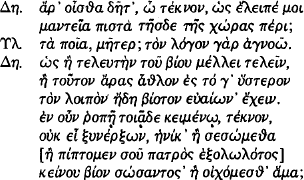No CrossRef data available.
Article contents
‘Either … or’ versus ‘both … and’: A Dramatic Device in Sophocles*
Published online by Cambridge University Press: 08 May 2015
Extract
In the prologue of the Women of Trachis, Deianeira is telling Hyllus of an oracle concerning her husband, Heracles, which is about to be fulfilled. The relevant passage (lines 76-85 of the OCT) is:

As Deianeira states it, a critical issue is about to be decided. Hitherto she has had an absentee husband; Heracles has visited her but rarely, spending most of his time abroad in various exploits – humanitarian, military, and sexual. But the gods (to be exact, the oracle of Zeus at Dodona) have decreed that this half-marriage will not continue. Either her husband will die, in which case she has no interest in surviving him, or his labours will come to an end and he will live in peace, which she interprets as a life of domestic bliss with her. She sends their son, Hyllus, to help him; later she will act more drastically and send a robe dyed in what she believes is a love-charm to rekindle his love for her, but is in fact a deadly poison. By the time he is brought back in his mortal agony, she will have killed herself, and his only feeling for her will be regret that her suicide has deprived him of taking vengeance on her. Such will be the consequences of her interpretation of the oracle.
- Type
- Research Article
- Information
- Copyright
- Copyright © Australasian Society for Classical Studies 1979
References
Bibliography
Note I have listed only recent discussions of the specific relevant passages, and have ignored standard works on Sophocles in general. A fuller bibliography will be found in my forthcoming book Problems in the Interpretation of Sophocles.




